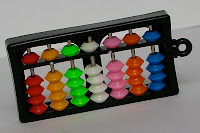For generations of Chinese traders and shopkeepers, the abacus (called suanpan) has been an indispensable tool for calculation and for finding the financial health of their business – the profit and loss of their trade.
 |
| Two Chinese and two Japanese abaci |
Less well known is that the suanpan is also used as a divination tool among many Chinese migrants. If you go to Chinatown today, you can still see old folks (who are usually the owners of their businesses) strike the beads of their abacuses before opening their shops in the morning. Striking the abacus is perceived to be a good omen: This primitive calculator will be used often throughout the day, indicating brisk business. And the louder they strike the beads, the better the business.
The choice of the beads (sizes, shapes and types) matters. The common beads are made of wood, stone, silver or gold, each serving a different purpose. For example, some beads are chosen as they allegedly help to secure a faster job promotion, while others to gain health and wealth.
 |
| A 4 cm by 2 cm Soroban |
So, the next time a friend gives you an ornament that comes with a cute-looking abacus as a gift, think twice before wearing it. You may unknowingly be the recipient of some superstitious or irrational belief that good luck is yours to come; or worst, if it's from some fiend or foe, you could be under the curse of some object of worship.
For reflection
0. How would you reason with (or respond to) someone who faithfully believes that abacus-pendants are to be worn for good omen?
1. Give five reasons why people use the abacus as a symbol of prosperity and wealth.
2. What are some dangers in using the abacus as a divination tool?
3. How can you educate the public that wearing abacus-pendants as a sign of good omen will only promote pseudoscience and innumeracy?
For Mathepreneurs ONLY
1. Design an abaculator.
2. Improvise a solar-powered soroban.
3. Invent an electrified suanpan.
© Yan Kow Cheong, 26 August, 2010